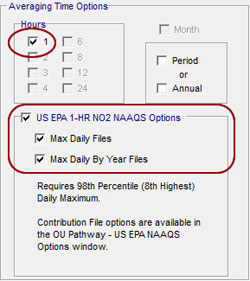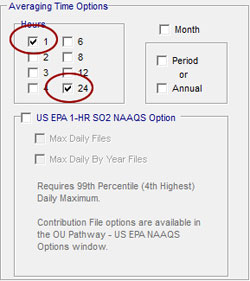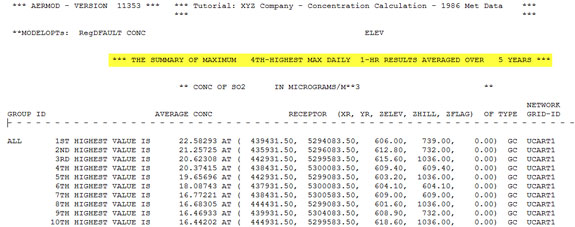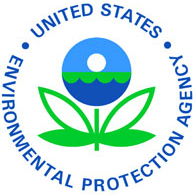Lakes Environmental e-Newsletter
In this issue:
- News & Events
- Upcoming Courses
- Modeling Tip: Modeling 1-hour NO2 and 1-hour SO2 with AERMOD View™
- Articles
- Upcoming Conferences & Trade Shows
News & Events
AERMOD View Version 7.4 Released
|
Lakes Environmental announced the release of AERMOD View Version 7.4 and AERMOD MPI Version 7.11353.0 to its base of users on January 10, 2012. Please find below a list of the main features implemented in this latest release:
For a detailed listing of updates available in AERMOD View Version 7.4, please check out our latest release notes. |
If you are currently in maintenance for AERMOD View and did not receive an email regarding this update, please contact us at support@webLakes.com.
If you are a user of AERMOD View, but are no longer in maintenance, please contact our Sales Team at LakesSoftware@webLakes.com for pricing to get up and running on version 7.4.
U.S. EPA Releases AERMOD & AERMINUTE Updates
Lakes Environmental recently released AERMOD View Version 7.4, which includes these U.S. EPA updates in addition to an update to AERMOD MPI for Version 11353. Users with current maintenance can log in to our Support Site now to download the update.
AERMOD and CALPUFF Courses in Dallas, Texas – Feb 27–Mar 2, 2012
|
Lakes Environmental will be in Dallas, Texas, to present a week of AERMOD and CALPUFF training from February 27 to March 2, 2012. CALPUFF students will have the opportunity to start and complete more than nine real-world case studies involving geophysical preprocessing, meteorological preprocessing, and CALMET, CALPUFF, and CALPOST modeling options. Register today to take advantage of our early registration discount! For further information, including details of the course location and registration form, please visit the Upcoming Courses section of our website. |
AERMOD Course in Toronto, Ontario - Feb 6-7, 2012 - A Few Spots Still Available!
The AERMOD course being held in Toronto from February 6 to 7, 2012 has just a few spots available. Don’t be left out! Register today! For additional information please contact us at training@webLakes.com.
Lakes Environmental Closed for Ontario’s Family Day Holiday
Lakes Environmental's Waterloo office will be closed on Monday, February 20th, 2012 to observe Ontario’s Family Day Holiday. Our Dallas office will remain open on this day. If you have any needs during that time, please e-mail us at support@webLakes.com and we will respond to your inquiry as soon as possible.
Upcoming Courses

Date |
Course |
Location |
Registration |
Feb 6-7, 2012 |
|||
Feb 27-28, 2012 |
|||
Apr 2-3, 2012 |
|||
May 7-9, 2012 |
Doha, Qatar |
Registration Coming Soon |
|
May 14-15, 2012 |
|||
Jun 4-5, 2012 |
|||
Sep 27-28, 2012 |
Mexico City, Mexico |
Registration Coming Soon |
|
Oct 15-16, 2012 |
London, UK |
Registration Coming Soon |
For more information on the above courses, including registration information, location, and course outlines, please visit our web site: https://www.weblakes.com/courses.html.
Modeling Tip
Modeling 1-hour NO2 and 1-hour SO2 with AERMOD View™
In 2010, the United States Environmental Protection Agency (U.S. EPA) made revisions to the National Ambient Air Quality Standards (NAAQS) for short-term nitrogen dioxide (NO2) and sulfur dioxide (SO2). While most U.S. NAAQS are based on high values, the revisions focused on annual distributions of daily maximum 1-hour values which air quality models like AERMOD could not readily produce.
To support processing for the 1-hour NO2 and 1-hour SO2, the U.S. EPA released a new version of AERMOD (11059) which included three new output file options and drastically changed the way in which AERMOD reports calculates concentrations for specific model options. The result is two distinct ways in which concentrations for 1-hour NO2 and SO2 are reported by the model.
Method 1 (Complying with the 2010 US EPA NAAQS Regulations)
This method describes the changes made to AERMOD to support the 1-hour U.S. NAAQS revisions:
- Open the Control Pathway window in AERMOD View™ and select the Pollutant/Averaging options.
- Select “SO2” or “NO2” from the drop-down list for Pollutant Type.

- Enable the US EPA 1-HR NO2 (or SO2) NAAQS Options check box. This will enable the model to produce new output file types: the maximum daily file and maximum daily by year file. These files can be used to explore modeled results in more detail.

- With this option enabled, only the 1-hour averaging period is available for selection. When the 1-hour period is selected by itself from the Hours list, the AERMOD model will calculate results based on the distribution of daily maximum 1-hour values.
- Meteorological data requirements remain unchanged – either 1 year of site-specific data or 5 years of National Weather Service data serve as an unbiased estimate of the “rolling 3-year average” referred to in the U.S. NAAQS. If modeling consecutive years, concatenate the SFC and PFL files together so that all years are processed in a single model run.
- On the Output Pathway, users can enable or disable the three new output file types via the US EPA NAAQS Options:
- MAXDAILY: for reviewing the daily maximum concentration at each receptor,
- MXDYBYYR: to see the highest daily maximum 1-hour concentration at each receptor for each processed year, and
- MAXDCONT: to analyze the contribution of user-defined source groups against ranked concentration values.
Method 2 (Not Complying with the 2010 US EPA NAAQS Regulations)
This method can be used by modelers who want to review 1-hour averages of NO2 or SO2 but do not want the results calculated using the U.S. NAAQS methodology.
- Open the Control Pathway window in AERMOD View™ and select the Pollutant/Averaging options.
- Select “SO2” or “NO2” from the drop-down list for Pollutant Type.

- Leave the US EPA 1-HR NO2 (or SO2) NAAQS Options box unchecked.
- In the Averaging Time Options, select the 1-hour average and at least one other short-term averaging period. By enabling multiple short-term averages, AERMOD will process 1-hour results based on the overall distribution of hourly values.

Output Differences Between Method 1 and Method 2
Modelers will see subtle differences in the output files produced by Method 1 when compared to Method 2.
With Method 1, the model tracks the maximum daily 1-hour average for each desired high value and averages those values across the number of years being processed. The maximum table, in the AERMOD output file, reports the results as “The Summary of Maximum nth-Highest Max Daily 1-HR Results Averaged Over y Years” where n is the user-specified high value (typically 4th highest for SO2 and 8th highest for NO2) and y is the number of years processed in the model run.

Method 2 results, on the other hand, are reported as “The Summary of Highest 1-HR Results” with no averaging done across multiple years and no maximum daily distribution performed by the model.

Submit Your Modeling Tip Today!
We are currently accepting submissions for the Monthly Modeling Tip section that appears in our newsletters. If you have a modeling tip that may benefit our readers, please send it to us at support@webLakes.com. Your name and the name of your organization will appear below the tip providing you with an opportunity for increased exposure.
Articles
2010 Greenhouse Gas Emissions Data from Large Facilities Now Available / First Release of Data Through the National GHG Reporting Program
WASHINGTON - January 11, 2012 - For the first time, comprehensive greenhouse gas (GHG) data reported directly from large facilities and suppliers across the country are now easily accessible to the public through EPA’s GHG Reporting Program. The 2010 GHG data released today includes public information from facilities in nine industry groups that directly emit large quantities of GHGs, as well as suppliers of certain fossil fuels.
“Thanks to strong collaboration and feedback from industry, states and other organizations, today we have a transparent, powerful data resource available to the public,” said Gina McCarthy, assistant administrator for EPA’s Office of Air and Radiation. “The GHG Reporting Program data provides a critical tool for businesses and other innovators to find cost- and fuel-saving efficiencies that reduce greenhouse gas emissions, and foster technologies to protect public health and the environment.”
EPA Issues First National Standards for Mercury Pollution from Power Plants/ Historic ‘Mercury and Air Toxics Standards’ Meet 20-year old Requirement to Cut Dangerous Smokestack Emissions
WASHINGTON - December 21, 2011 - The U.S. Environmental Protection Agency (EPA) has issued the Mercury and Air Toxics Standards, the first national standards to protect American families from power plant emissions of mercury and toxic air pollution like arsenic, acid gas, nickel, selenium, and cyanide. The standards will slash emissions of these dangerous pollutants by relying on widely available, proven pollution controls that are already in use at more than half of the nation’s coal-fired power plants.
EPA estimates that the new safeguards will prevent as many as 11,000 premature deaths and 4,700 heart attacks a year. The standards will also help America’s children grow up healthier – preventing 130,000 cases of childhood asthma symptoms and about 6,300 fewer cases of acute bronchitis among children each year.
Industrial Air Pollution Cost Europe up to €169 Billion in 2009, EEA Reveals
January 6, 2012 - Air pollution from the 10,000 largest polluting facilities in Europe cost citizens between € 102 and 169 billion in 2009. This was one of the findings of a new report from the European Environment Agency (EEA) which analysed the costs of harm to health and the environment caused by air pollution. Half of the total damage cost (between € 51 and 85 billion) was caused by just 191 facilities.
The report, 'Revealing the costs of air pollution from industrial facilities in Europe', provides a list of the individual facilities that contribute the most harm.
“Our analysis reveals the high cost caused by pollution from power stations and other large industrial plants,” Professor Jacqueline McGlade, EEA Executive Director, said.
Government of Canada Adds 41 Hazardous Substances to Emergency Regulations
OTTAWA - December 21, 2011 - Canada's Environment Minister, the Honourable Peter Kent, today announced the addition of 41 unique substances to the Environmental Emergency Regulations. The substances include styrene, an explosive chemical used to make polystyrene plastic containers, and ammonium nitrate, a fertilizer.
"The Government of Canada continues to meet its commitment to protect Canadians and safeguard our environment," said Minister Kent. "These amendments to the Environmental Emergency Regulations will further protect Canadians where it matters most: at work, in their homes and in their communities."
Thirty-three substances in use in Canadian commerce, in several physical states, and some substances classed in their different forms are now added to the Environmental Emergency Regulations, for a total of 41 unique listed additions.
Upcoming Conferences & Trade Shows
Date |
Conference |
Location |
Jan 30- Feb 1, 2012 |
EUEC 2012 |
Phoenix, AZ, USA |
Feb 13-14, 2012 |
EnerCan West 2012: Energy and the Environment |
Regina, SK, Canada |
Feb 14-16, 2012 |
Renewable Energy World Conference & Expo North America |
Long Beach, CA, USA |
Mar 14-16, 2012 |
GLOBE 2012 |
Vancouver, BC, Canada |
Mar 17-18, 2012 |
2012 International Conference on Informatics, Environment, Energy and Applications (IEEA 2012)
|
Singapore |
Mar 19-23, 2012 |
8th International Conference on Air Quality |
Athens, Greece |
Mar 25-27, 2012 |
Gulf Environment Forum 2012 |
Jeddah, Saudi Arabia |
Apr 22-27, 2012 |
International Polar Year (IPY) 2012 Conference |
Montréal, QC, Canada |
Apr 30 - May 2, 2012 |
CANECT 2012 |
Mississauga, ON, Canada |
May 23-24, 2012 |
34th Motorship Propulsions and Emissions Conference |
Hamburg, Germany |
Jun 19-22, 2012 |
A&WMA 105th Annual Conference and Exhibition |
San Antonio, TX, USA |
About this Newsletter
This newsletter contains information gleaned from various sources on the web, with complete links to the sources cited. Organizations cited are in no way affiliated with Lakes Environmental Software.
Lakes Environmental Software is a leading environmental IT company that offers a complete line of air dispersion modeling, risk assessment, emissions inventory, and emergency release software as well as training and custom software services. With satisfied users located around the globe, Lakes Environmental Software will continue to revolutionize the environmental software field.
For more information please visit our web site at: www.webLakes.com. You may also contact us by phone at (519) 746-5995 or by fax at (519)746-0793.
All comments and suggestions are welcome. You can e-mail us at: support@webLakes.com.





